The departments of the organization
VerifiedAdded on 2022/09/01
|9
|2580
|31
AI Summary
Contribute Materials
Your contribution can guide someone’s learning journey. Share your
documents today.

SOCIAL SCIENCE
SOCIAL SCIENCE
Name of Student
Name of University
Author note
SOCIAL SCIENCE
Name of Student
Name of University
Author note
Secure Best Marks with AI Grader
Need help grading? Try our AI Grader for instant feedback on your assignments.
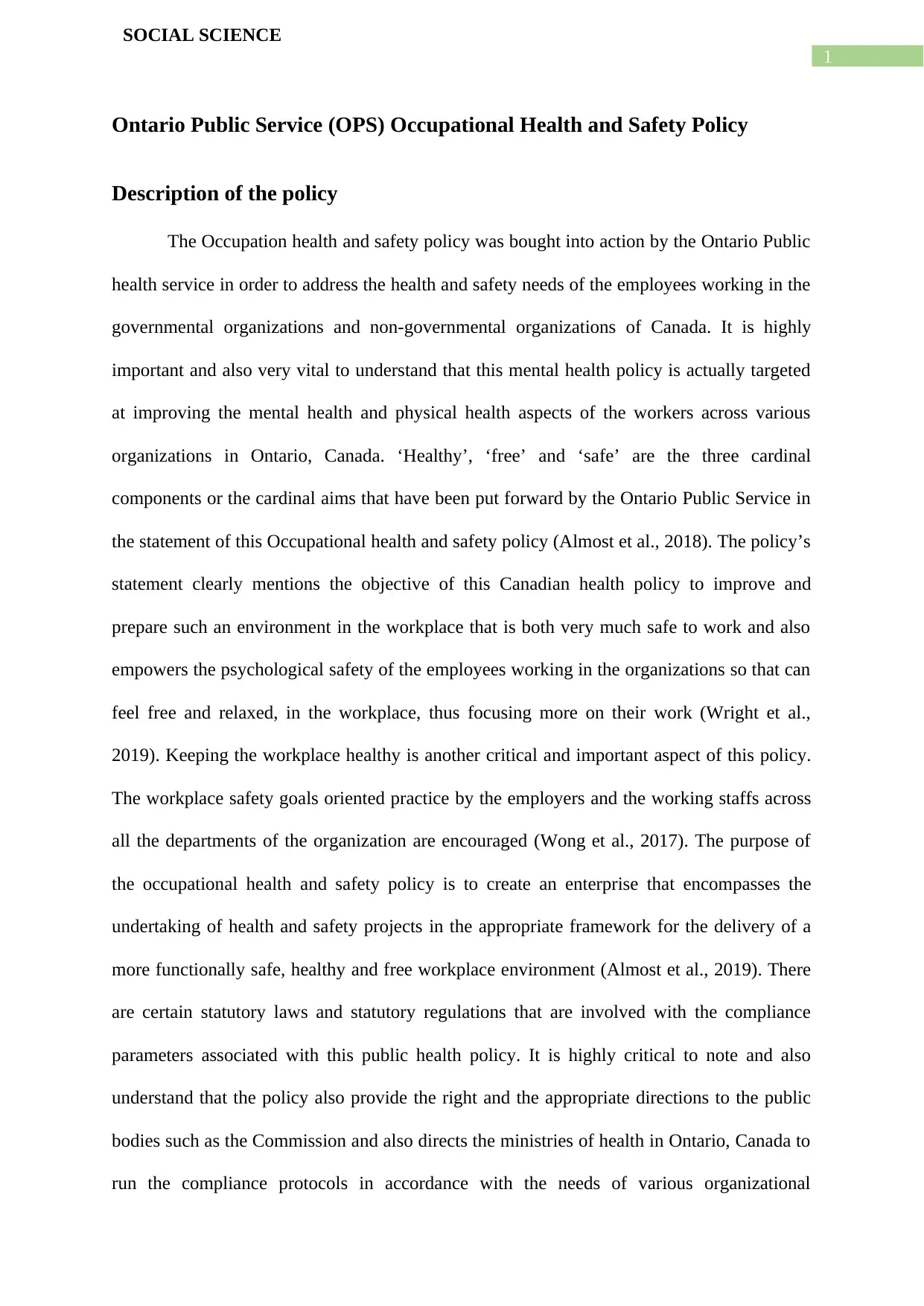
1
SOCIAL SCIENCE
Ontario Public Service (OPS) Occupational Health and Safety Policy
Description of the policy
The Occupation health and safety policy was bought into action by the Ontario Public
health service in order to address the health and safety needs of the employees working in the
governmental organizations and non-governmental organizations of Canada. It is highly
important and also very vital to understand that this mental health policy is actually targeted
at improving the mental health and physical health aspects of the workers across various
organizations in Ontario, Canada. ‘Healthy’, ‘free’ and ‘safe’ are the three cardinal
components or the cardinal aims that have been put forward by the Ontario Public Service in
the statement of this Occupational health and safety policy (Almost et al., 2018). The policy’s
statement clearly mentions the objective of this Canadian health policy to improve and
prepare such an environment in the workplace that is both very much safe to work and also
empowers the psychological safety of the employees working in the organizations so that can
feel free and relaxed, in the workplace, thus focusing more on their work (Wright et al.,
2019). Keeping the workplace healthy is another critical and important aspect of this policy.
The workplace safety goals oriented practice by the employers and the working staffs across
all the departments of the organization are encouraged (Wong et al., 2017). The purpose of
the occupational health and safety policy is to create an enterprise that encompasses the
undertaking of health and safety projects in the appropriate framework for the delivery of a
more functionally safe, healthy and free workplace environment (Almost et al., 2019). There
are certain statutory laws and statutory regulations that are involved with the compliance
parameters associated with this public health policy. It is highly critical to note and also
understand that the policy also provide the right and the appropriate directions to the public
bodies such as the Commission and also directs the ministries of health in Ontario, Canada to
run the compliance protocols in accordance with the needs of various organizational
SOCIAL SCIENCE
Ontario Public Service (OPS) Occupational Health and Safety Policy
Description of the policy
The Occupation health and safety policy was bought into action by the Ontario Public
health service in order to address the health and safety needs of the employees working in the
governmental organizations and non-governmental organizations of Canada. It is highly
important and also very vital to understand that this mental health policy is actually targeted
at improving the mental health and physical health aspects of the workers across various
organizations in Ontario, Canada. ‘Healthy’, ‘free’ and ‘safe’ are the three cardinal
components or the cardinal aims that have been put forward by the Ontario Public Service in
the statement of this Occupational health and safety policy (Almost et al., 2018). The policy’s
statement clearly mentions the objective of this Canadian health policy to improve and
prepare such an environment in the workplace that is both very much safe to work and also
empowers the psychological safety of the employees working in the organizations so that can
feel free and relaxed, in the workplace, thus focusing more on their work (Wright et al.,
2019). Keeping the workplace healthy is another critical and important aspect of this policy.
The workplace safety goals oriented practice by the employers and the working staffs across
all the departments of the organization are encouraged (Wong et al., 2017). The purpose of
the occupational health and safety policy is to create an enterprise that encompasses the
undertaking of health and safety projects in the appropriate framework for the delivery of a
more functionally safe, healthy and free workplace environment (Almost et al., 2019). There
are certain statutory laws and statutory regulations that are involved with the compliance
parameters associated with this public health policy. It is highly critical to note and also
understand that the policy also provide the right and the appropriate directions to the public
bodies such as the Commission and also directs the ministries of health in Ontario, Canada to
run the compliance protocols in accordance with the needs of various organizational
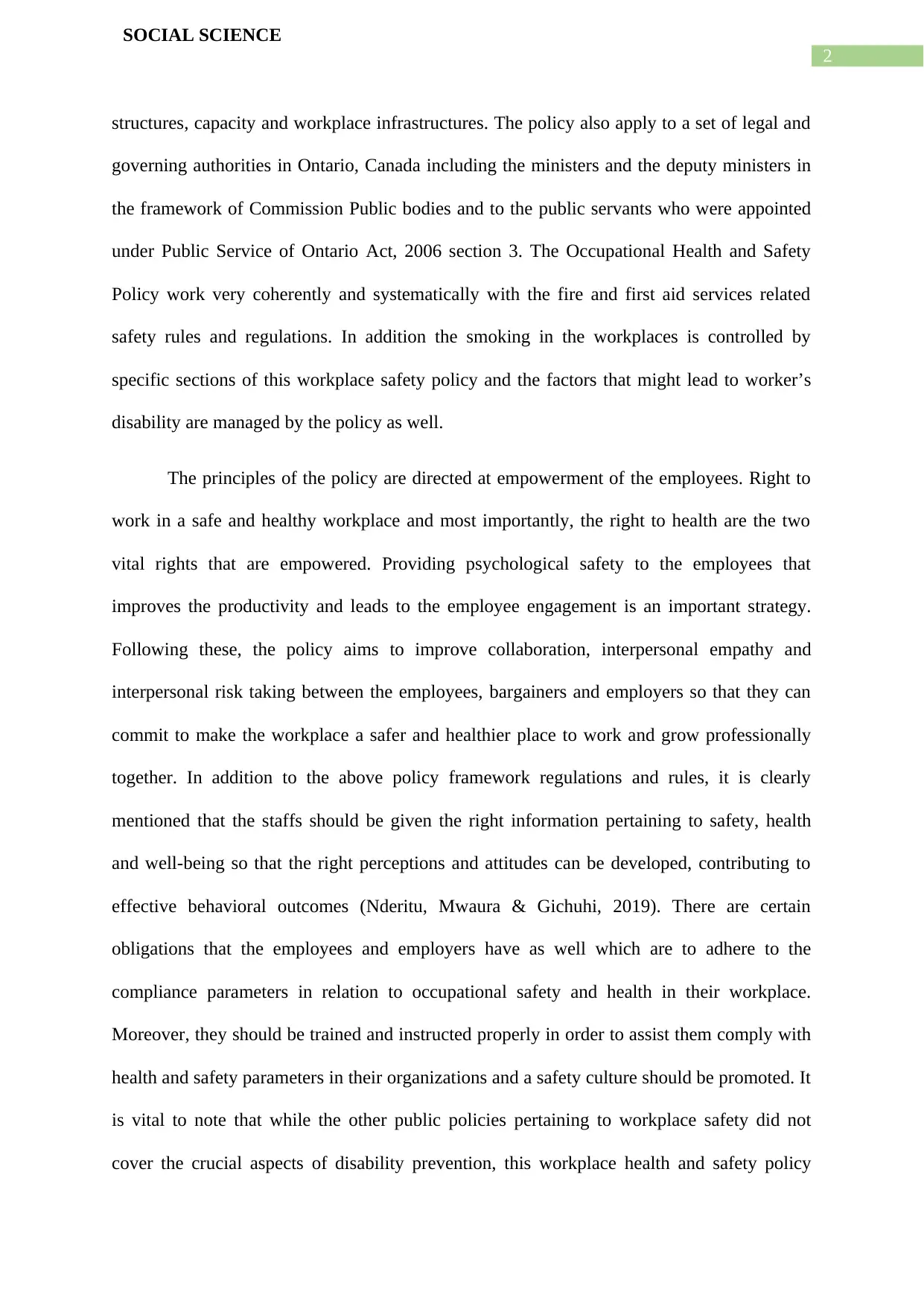
2
SOCIAL SCIENCE
structures, capacity and workplace infrastructures. The policy also apply to a set of legal and
governing authorities in Ontario, Canada including the ministers and the deputy ministers in
the framework of Commission Public bodies and to the public servants who were appointed
under Public Service of Ontario Act, 2006 section 3. The Occupational Health and Safety
Policy work very coherently and systematically with the fire and first aid services related
safety rules and regulations. In addition the smoking in the workplaces is controlled by
specific sections of this workplace safety policy and the factors that might lead to worker’s
disability are managed by the policy as well.
The principles of the policy are directed at empowerment of the employees. Right to
work in a safe and healthy workplace and most importantly, the right to health are the two
vital rights that are empowered. Providing psychological safety to the employees that
improves the productivity and leads to the employee engagement is an important strategy.
Following these, the policy aims to improve collaboration, interpersonal empathy and
interpersonal risk taking between the employees, bargainers and employers so that they can
commit to make the workplace a safer and healthier place to work and grow professionally
together. In addition to the above policy framework regulations and rules, it is clearly
mentioned that the staffs should be given the right information pertaining to safety, health
and well-being so that the right perceptions and attitudes can be developed, contributing to
effective behavioral outcomes (Nderitu, Mwaura & Gichuhi, 2019). There are certain
obligations that the employees and employers have as well which are to adhere to the
compliance parameters in relation to occupational safety and health in their workplace.
Moreover, they should be trained and instructed properly in order to assist them comply with
health and safety parameters in their organizations and a safety culture should be promoted. It
is vital to note that while the other public policies pertaining to workplace safety did not
cover the crucial aspects of disability prevention, this workplace health and safety policy
SOCIAL SCIENCE
structures, capacity and workplace infrastructures. The policy also apply to a set of legal and
governing authorities in Ontario, Canada including the ministers and the deputy ministers in
the framework of Commission Public bodies and to the public servants who were appointed
under Public Service of Ontario Act, 2006 section 3. The Occupational Health and Safety
Policy work very coherently and systematically with the fire and first aid services related
safety rules and regulations. In addition the smoking in the workplaces is controlled by
specific sections of this workplace safety policy and the factors that might lead to worker’s
disability are managed by the policy as well.
The principles of the policy are directed at empowerment of the employees. Right to
work in a safe and healthy workplace and most importantly, the right to health are the two
vital rights that are empowered. Providing psychological safety to the employees that
improves the productivity and leads to the employee engagement is an important strategy.
Following these, the policy aims to improve collaboration, interpersonal empathy and
interpersonal risk taking between the employees, bargainers and employers so that they can
commit to make the workplace a safer and healthier place to work and grow professionally
together. In addition to the above policy framework regulations and rules, it is clearly
mentioned that the staffs should be given the right information pertaining to safety, health
and well-being so that the right perceptions and attitudes can be developed, contributing to
effective behavioral outcomes (Nderitu, Mwaura & Gichuhi, 2019). There are certain
obligations that the employees and employers have as well which are to adhere to the
compliance parameters in relation to occupational safety and health in their workplace.
Moreover, they should be trained and instructed properly in order to assist them comply with
health and safety parameters in their organizations and a safety culture should be promoted. It
is vital to note that while the other public policies pertaining to workplace safety did not
cover the crucial aspects of disability prevention, this workplace health and safety policy
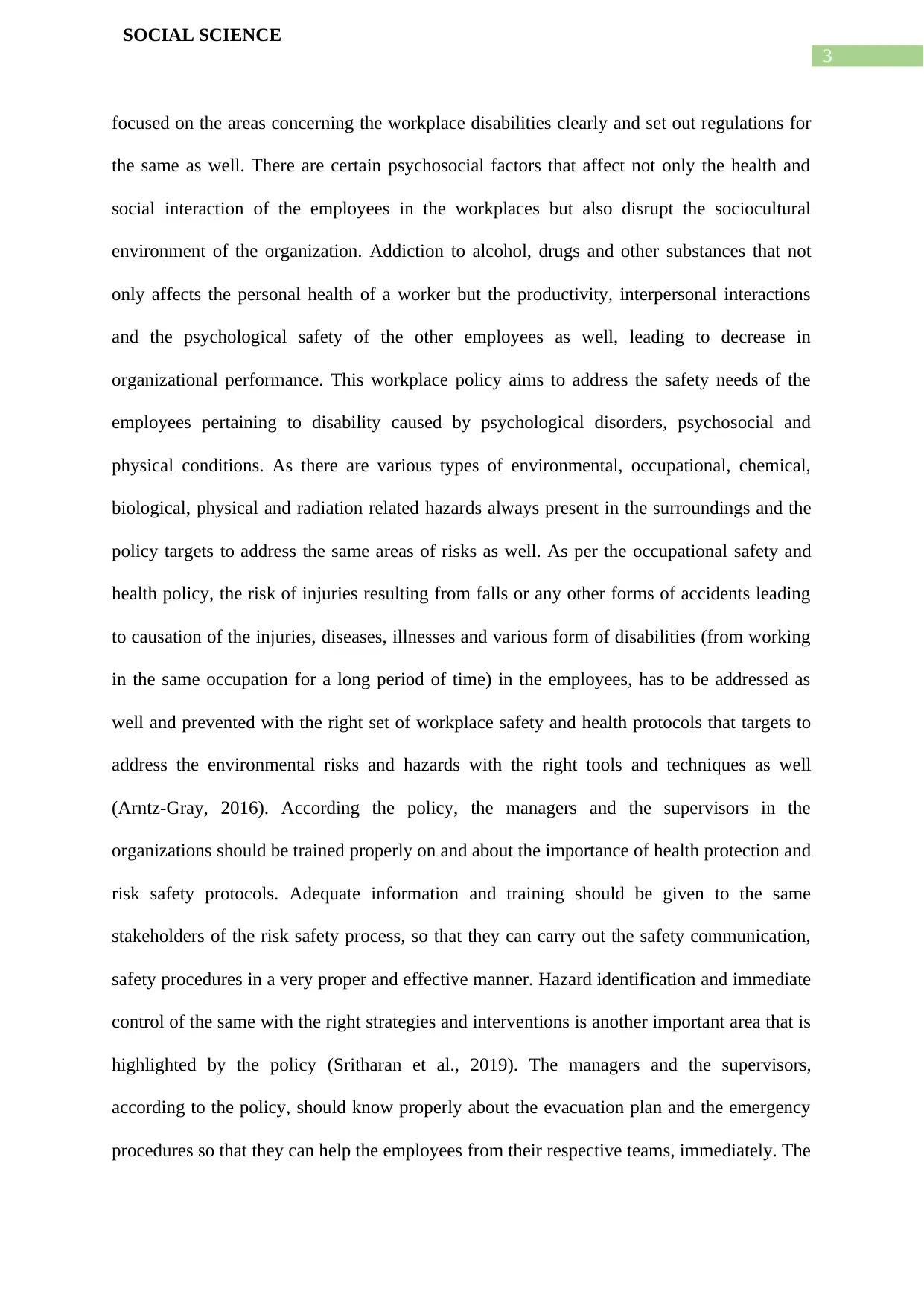
3
SOCIAL SCIENCE
focused on the areas concerning the workplace disabilities clearly and set out regulations for
the same as well. There are certain psychosocial factors that affect not only the health and
social interaction of the employees in the workplaces but also disrupt the sociocultural
environment of the organization. Addiction to alcohol, drugs and other substances that not
only affects the personal health of a worker but the productivity, interpersonal interactions
and the psychological safety of the other employees as well, leading to decrease in
organizational performance. This workplace policy aims to address the safety needs of the
employees pertaining to disability caused by psychological disorders, psychosocial and
physical conditions. As there are various types of environmental, occupational, chemical,
biological, physical and radiation related hazards always present in the surroundings and the
policy targets to address the same areas of risks as well. As per the occupational safety and
health policy, the risk of injuries resulting from falls or any other forms of accidents leading
to causation of the injuries, diseases, illnesses and various form of disabilities (from working
in the same occupation for a long period of time) in the employees, has to be addressed as
well and prevented with the right set of workplace safety and health protocols that targets to
address the environmental risks and hazards with the right tools and techniques as well
(Arntz-Gray, 2016). According the policy, the managers and the supervisors in the
organizations should be trained properly on and about the importance of health protection and
risk safety protocols. Adequate information and training should be given to the same
stakeholders of the risk safety process, so that they can carry out the safety communication,
safety procedures in a very proper and effective manner. Hazard identification and immediate
control of the same with the right strategies and interventions is another important area that is
highlighted by the policy (Sritharan et al., 2019). The managers and the supervisors,
according to the policy, should know properly about the evacuation plan and the emergency
procedures so that they can help the employees from their respective teams, immediately. The
SOCIAL SCIENCE
focused on the areas concerning the workplace disabilities clearly and set out regulations for
the same as well. There are certain psychosocial factors that affect not only the health and
social interaction of the employees in the workplaces but also disrupt the sociocultural
environment of the organization. Addiction to alcohol, drugs and other substances that not
only affects the personal health of a worker but the productivity, interpersonal interactions
and the psychological safety of the other employees as well, leading to decrease in
organizational performance. This workplace policy aims to address the safety needs of the
employees pertaining to disability caused by psychological disorders, psychosocial and
physical conditions. As there are various types of environmental, occupational, chemical,
biological, physical and radiation related hazards always present in the surroundings and the
policy targets to address the same areas of risks as well. As per the occupational safety and
health policy, the risk of injuries resulting from falls or any other forms of accidents leading
to causation of the injuries, diseases, illnesses and various form of disabilities (from working
in the same occupation for a long period of time) in the employees, has to be addressed as
well and prevented with the right set of workplace safety and health protocols that targets to
address the environmental risks and hazards with the right tools and techniques as well
(Arntz-Gray, 2016). According the policy, the managers and the supervisors in the
organizations should be trained properly on and about the importance of health protection and
risk safety protocols. Adequate information and training should be given to the same
stakeholders of the risk safety process, so that they can carry out the safety communication,
safety procedures in a very proper and effective manner. Hazard identification and immediate
control of the same with the right strategies and interventions is another important area that is
highlighted by the policy (Sritharan et al., 2019). The managers and the supervisors,
according to the policy, should know properly about the evacuation plan and the emergency
procedures so that they can help the employees from their respective teams, immediately. The
Secure Best Marks with AI Grader
Need help grading? Try our AI Grader for instant feedback on your assignments.
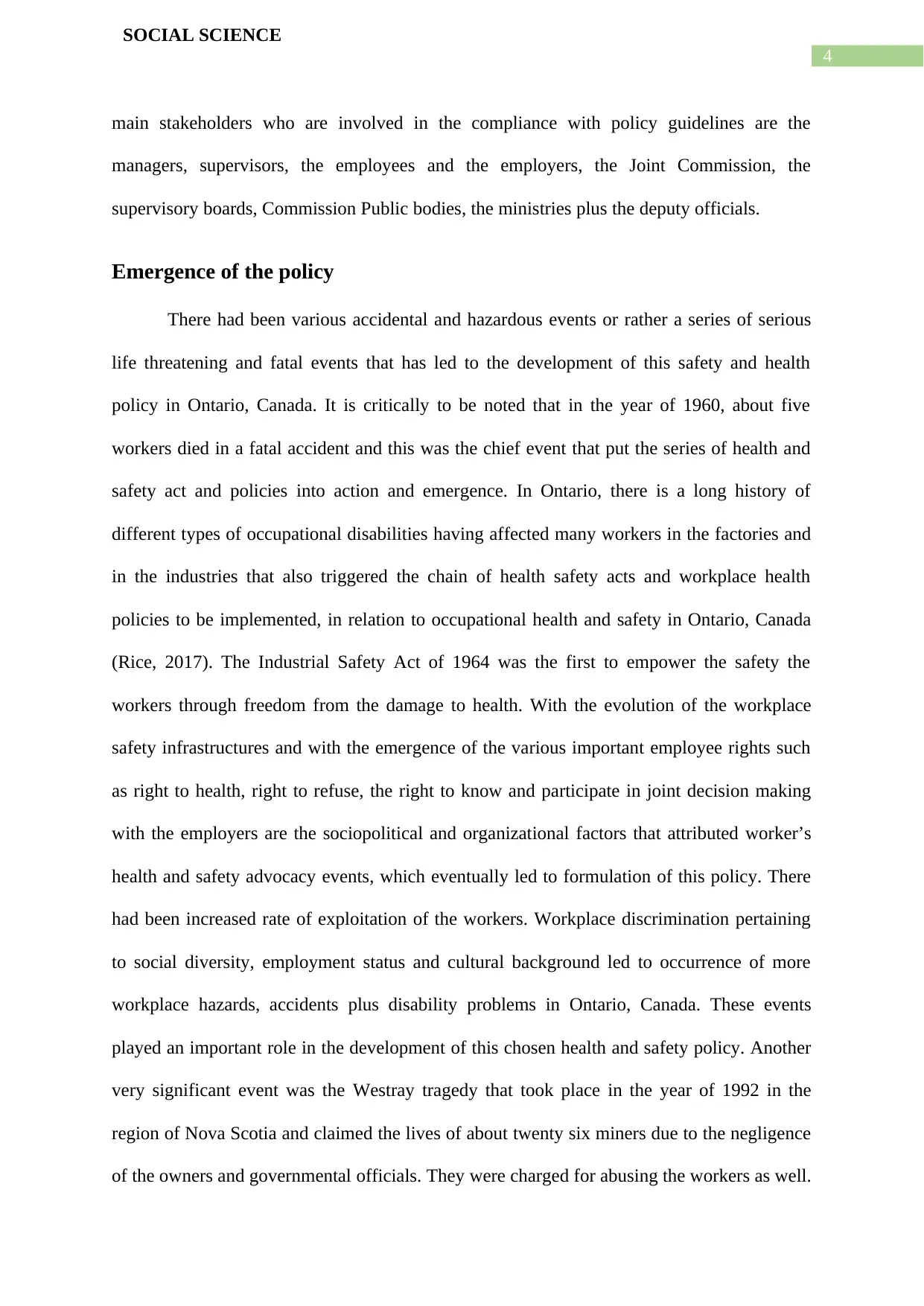
4
SOCIAL SCIENCE
main stakeholders who are involved in the compliance with policy guidelines are the
managers, supervisors, the employees and the employers, the Joint Commission, the
supervisory boards, Commission Public bodies, the ministries plus the deputy officials.
Emergence of the policy
There had been various accidental and hazardous events or rather a series of serious
life threatening and fatal events that has led to the development of this safety and health
policy in Ontario, Canada. It is critically to be noted that in the year of 1960, about five
workers died in a fatal accident and this was the chief event that put the series of health and
safety act and policies into action and emergence. In Ontario, there is a long history of
different types of occupational disabilities having affected many workers in the factories and
in the industries that also triggered the chain of health safety acts and workplace health
policies to be implemented, in relation to occupational health and safety in Ontario, Canada
(Rice, 2017). The Industrial Safety Act of 1964 was the first to empower the safety the
workers through freedom from the damage to health. With the evolution of the workplace
safety infrastructures and with the emergence of the various important employee rights such
as right to health, right to refuse, the right to know and participate in joint decision making
with the employers are the sociopolitical and organizational factors that attributed worker’s
health and safety advocacy events, which eventually led to formulation of this policy. There
had been increased rate of exploitation of the workers. Workplace discrimination pertaining
to social diversity, employment status and cultural background led to occurrence of more
workplace hazards, accidents plus disability problems in Ontario, Canada. These events
played an important role in the development of this chosen health and safety policy. Another
very significant event was the Westray tragedy that took place in the year of 1992 in the
region of Nova Scotia and claimed the lives of about twenty six miners due to the negligence
of the owners and governmental officials. They were charged for abusing the workers as well.
SOCIAL SCIENCE
main stakeholders who are involved in the compliance with policy guidelines are the
managers, supervisors, the employees and the employers, the Joint Commission, the
supervisory boards, Commission Public bodies, the ministries plus the deputy officials.
Emergence of the policy
There had been various accidental and hazardous events or rather a series of serious
life threatening and fatal events that has led to the development of this safety and health
policy in Ontario, Canada. It is critically to be noted that in the year of 1960, about five
workers died in a fatal accident and this was the chief event that put the series of health and
safety act and policies into action and emergence. In Ontario, there is a long history of
different types of occupational disabilities having affected many workers in the factories and
in the industries that also triggered the chain of health safety acts and workplace health
policies to be implemented, in relation to occupational health and safety in Ontario, Canada
(Rice, 2017). The Industrial Safety Act of 1964 was the first to empower the safety the
workers through freedom from the damage to health. With the evolution of the workplace
safety infrastructures and with the emergence of the various important employee rights such
as right to health, right to refuse, the right to know and participate in joint decision making
with the employers are the sociopolitical and organizational factors that attributed worker’s
health and safety advocacy events, which eventually led to formulation of this policy. There
had been increased rate of exploitation of the workers. Workplace discrimination pertaining
to social diversity, employment status and cultural background led to occurrence of more
workplace hazards, accidents plus disability problems in Ontario, Canada. These events
played an important role in the development of this chosen health and safety policy. Another
very significant event was the Westray tragedy that took place in the year of 1992 in the
region of Nova Scotia and claimed the lives of about twenty six miners due to the negligence
of the owners and governmental officials. They were charged for abusing the workers as well.

5
SOCIAL SCIENCE
The complaints and reports arising from the workplace violence and disruption of
psychological safety due to confined spaces were the other major events that led to this
workplace safety and health policy.
Response to question 2
The benefits of the issues are multi-faceted. As per the policy – from the employees to
the employers to the ministries and chairpersons are equally responsible for the promotion
and maintenance of the occupational health and safety regulations in a workplace and this
promotes equity and diversity and reduces bias. The benefits include staff training and staff
development pertaining to occupational safety. The training and development of the
managers and supervisors in addition to delivery of the right and appropriate information to
the workers are the vital underpinnings of the workplace health and safety maintenance (St-
Amant, P2017). The other important advantages of this occupational health policy is that it
covers the critical services that provides health protection of the employees against the
hazards accidents and risks posed by environmental factors such as fire, electrical shock,
radiation as well as against the risks posed by psychosocial disruptions. The policy also
addresses the safety related problems imperatively that might arise in the workplace
pertaining to psychosocial behaviors of smoking, drinking alcohol and other forms of
substance abuse in the workplace that might lead to further disruption and issues with health
and safety in the workplace (Prince, 2018). The functions of governmental bodies in
development of workplace safety are clearly mentioned that makes the policy more
purposeful and valid (Yanar et al., 2020).
The policy is evidence based as the support services protocols described are well
supported with evidence based occupational health and safety scientific literature. There is a
SOCIAL SCIENCE
The complaints and reports arising from the workplace violence and disruption of
psychological safety due to confined spaces were the other major events that led to this
workplace safety and health policy.
Response to question 2
The benefits of the issues are multi-faceted. As per the policy – from the employees to
the employers to the ministries and chairpersons are equally responsible for the promotion
and maintenance of the occupational health and safety regulations in a workplace and this
promotes equity and diversity and reduces bias. The benefits include staff training and staff
development pertaining to occupational safety. The training and development of the
managers and supervisors in addition to delivery of the right and appropriate information to
the workers are the vital underpinnings of the workplace health and safety maintenance (St-
Amant, P2017). The other important advantages of this occupational health policy is that it
covers the critical services that provides health protection of the employees against the
hazards accidents and risks posed by environmental factors such as fire, electrical shock,
radiation as well as against the risks posed by psychosocial disruptions. The policy also
addresses the safety related problems imperatively that might arise in the workplace
pertaining to psychosocial behaviors of smoking, drinking alcohol and other forms of
substance abuse in the workplace that might lead to further disruption and issues with health
and safety in the workplace (Prince, 2018). The functions of governmental bodies in
development of workplace safety are clearly mentioned that makes the policy more
purposeful and valid (Yanar et al., 2020).
The policy is evidence based as the support services protocols described are well
supported with evidence based occupational health and safety scientific literature. There is a
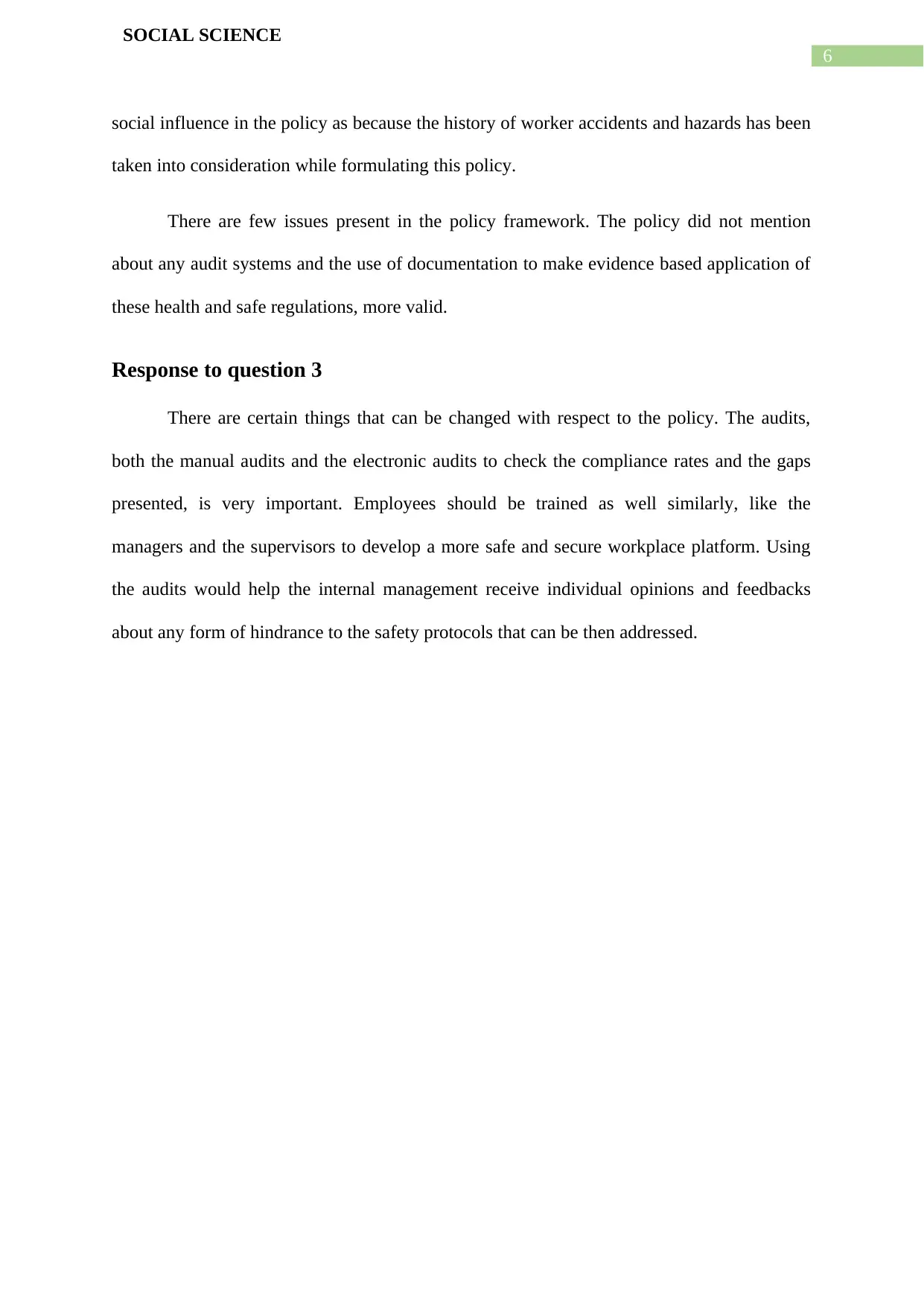
6
SOCIAL SCIENCE
social influence in the policy as because the history of worker accidents and hazards has been
taken into consideration while formulating this policy.
There are few issues present in the policy framework. The policy did not mention
about any audit systems and the use of documentation to make evidence based application of
these health and safe regulations, more valid.
Response to question 3
There are certain things that can be changed with respect to the policy. The audits,
both the manual audits and the electronic audits to check the compliance rates and the gaps
presented, is very important. Employees should be trained as well similarly, like the
managers and the supervisors to develop a more safe and secure workplace platform. Using
the audits would help the internal management receive individual opinions and feedbacks
about any form of hindrance to the safety protocols that can be then addressed.
SOCIAL SCIENCE
social influence in the policy as because the history of worker accidents and hazards has been
taken into consideration while formulating this policy.
There are few issues present in the policy framework. The policy did not mention
about any audit systems and the use of documentation to make evidence based application of
these health and safe regulations, more valid.
Response to question 3
There are certain things that can be changed with respect to the policy. The audits,
both the manual audits and the electronic audits to check the compliance rates and the gaps
presented, is very important. Employees should be trained as well similarly, like the
managers and the supervisors to develop a more safe and secure workplace platform. Using
the audits would help the internal management receive individual opinions and feedbacks
about any form of hindrance to the safety protocols that can be then addressed.
Paraphrase This Document
Need a fresh take? Get an instant paraphrase of this document with our AI Paraphraser
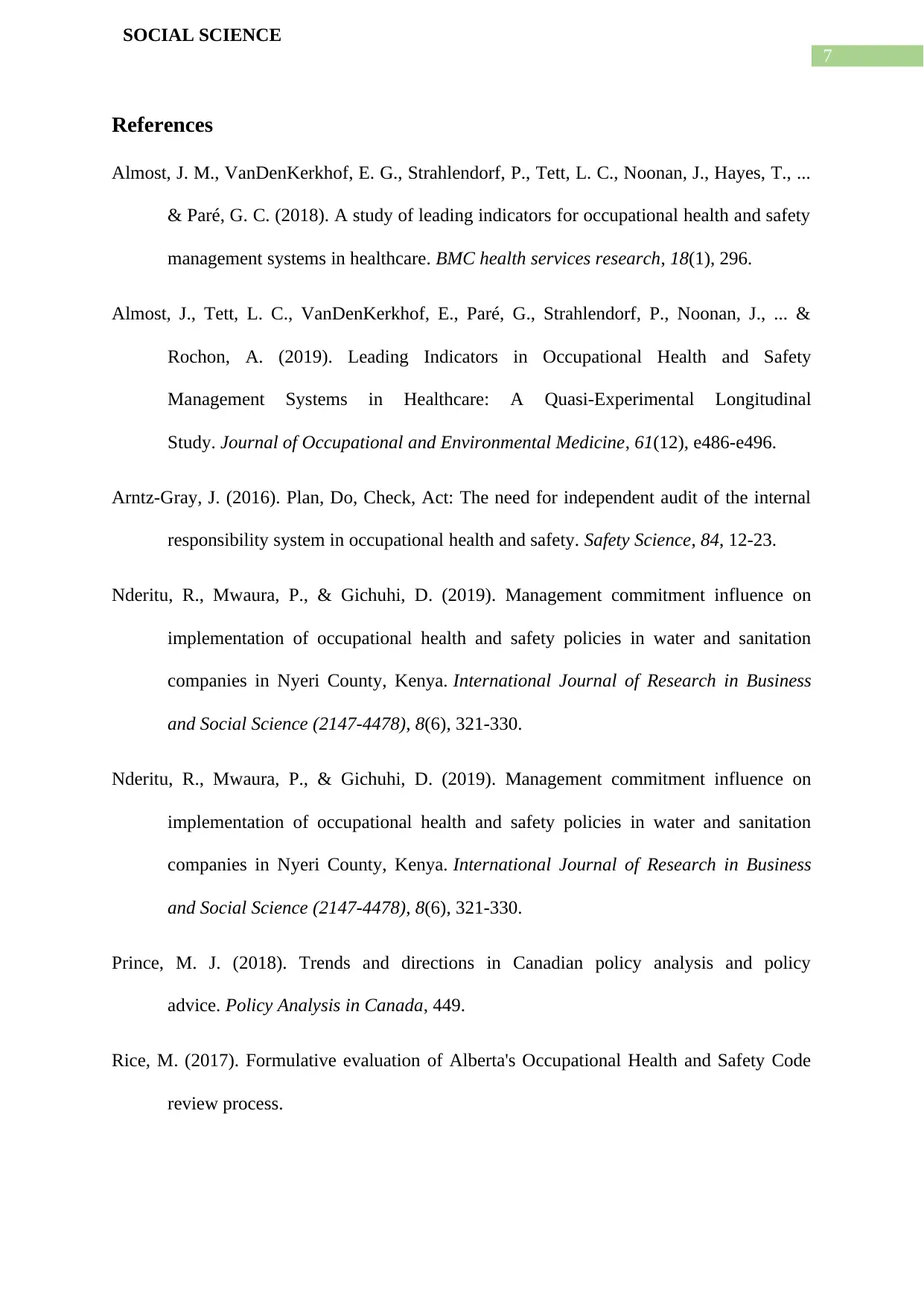
7
SOCIAL SCIENCE
References
Almost, J. M., VanDenKerkhof, E. G., Strahlendorf, P., Tett, L. C., Noonan, J., Hayes, T., ...
& Paré, G. C. (2018). A study of leading indicators for occupational health and safety
management systems in healthcare. BMC health services research, 18(1), 296.
Almost, J., Tett, L. C., VanDenKerkhof, E., Paré, G., Strahlendorf, P., Noonan, J., ... &
Rochon, A. (2019). Leading Indicators in Occupational Health and Safety
Management Systems in Healthcare: A Quasi-Experimental Longitudinal
Study. Journal of Occupational and Environmental Medicine, 61(12), e486-e496.
Arntz-Gray, J. (2016). Plan, Do, Check, Act: The need for independent audit of the internal
responsibility system in occupational health and safety. Safety Science, 84, 12-23.
Nderitu, R., Mwaura, P., & Gichuhi, D. (2019). Management commitment influence on
implementation of occupational health and safety policies in water and sanitation
companies in Nyeri County, Kenya. International Journal of Research in Business
and Social Science (2147-4478), 8(6), 321-330.
Nderitu, R., Mwaura, P., & Gichuhi, D. (2019). Management commitment influence on
implementation of occupational health and safety policies in water and sanitation
companies in Nyeri County, Kenya. International Journal of Research in Business
and Social Science (2147-4478), 8(6), 321-330.
Prince, M. J. (2018). Trends and directions in Canadian policy analysis and policy
advice. Policy Analysis in Canada, 449.
Rice, M. (2017). Formulative evaluation of Alberta's Occupational Health and Safety Code
review process.
SOCIAL SCIENCE
References
Almost, J. M., VanDenKerkhof, E. G., Strahlendorf, P., Tett, L. C., Noonan, J., Hayes, T., ...
& Paré, G. C. (2018). A study of leading indicators for occupational health and safety
management systems in healthcare. BMC health services research, 18(1), 296.
Almost, J., Tett, L. C., VanDenKerkhof, E., Paré, G., Strahlendorf, P., Noonan, J., ... &
Rochon, A. (2019). Leading Indicators in Occupational Health and Safety
Management Systems in Healthcare: A Quasi-Experimental Longitudinal
Study. Journal of Occupational and Environmental Medicine, 61(12), e486-e496.
Arntz-Gray, J. (2016). Plan, Do, Check, Act: The need for independent audit of the internal
responsibility system in occupational health and safety. Safety Science, 84, 12-23.
Nderitu, R., Mwaura, P., & Gichuhi, D. (2019). Management commitment influence on
implementation of occupational health and safety policies in water and sanitation
companies in Nyeri County, Kenya. International Journal of Research in Business
and Social Science (2147-4478), 8(6), 321-330.
Nderitu, R., Mwaura, P., & Gichuhi, D. (2019). Management commitment influence on
implementation of occupational health and safety policies in water and sanitation
companies in Nyeri County, Kenya. International Journal of Research in Business
and Social Science (2147-4478), 8(6), 321-330.
Prince, M. J. (2018). Trends and directions in Canadian policy analysis and policy
advice. Policy Analysis in Canada, 449.
Rice, M. (2017). Formulative evaluation of Alberta's Occupational Health and Safety Code
review process.
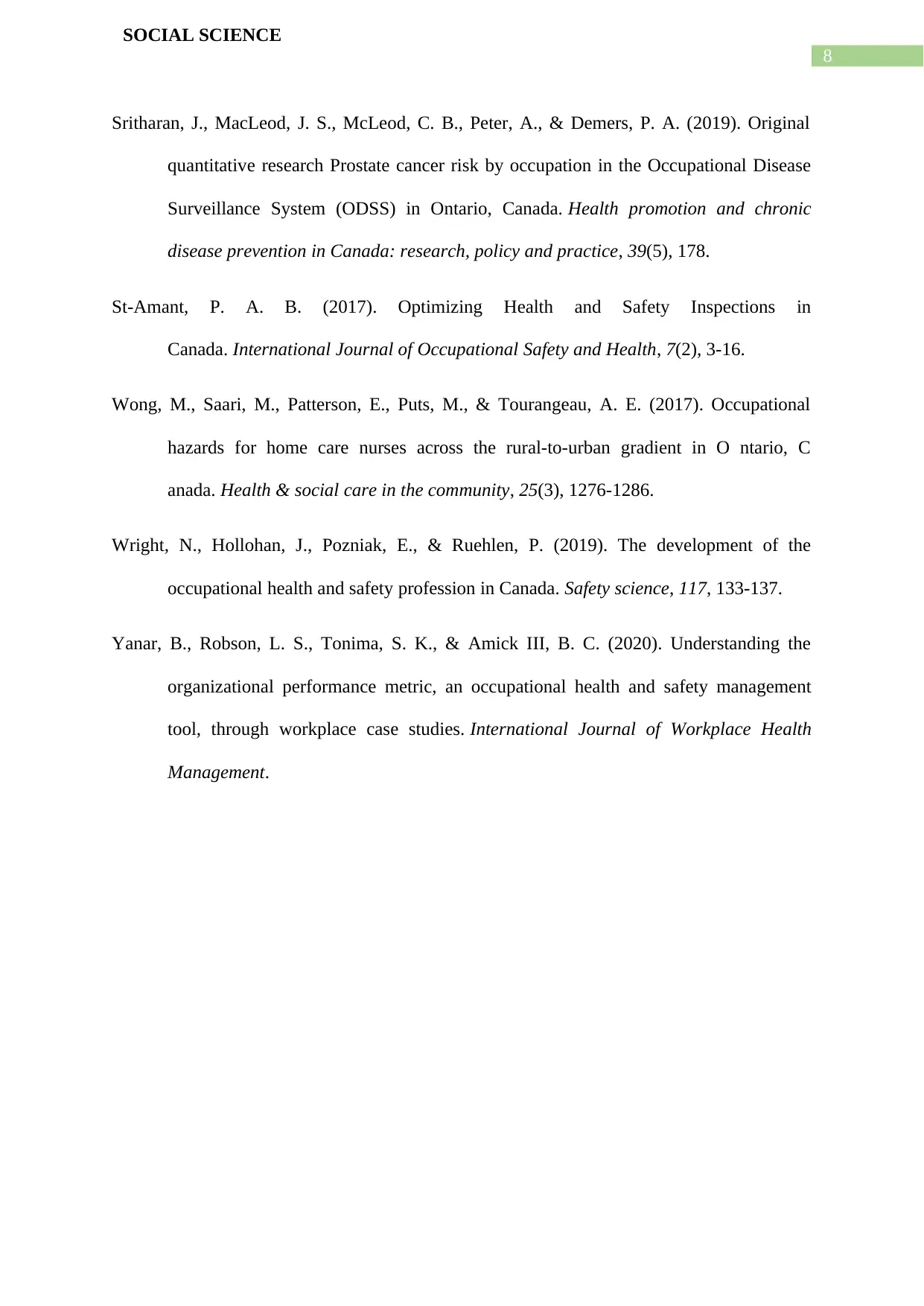
8
SOCIAL SCIENCE
Sritharan, J., MacLeod, J. S., McLeod, C. B., Peter, A., & Demers, P. A. (2019). Original
quantitative research Prostate cancer risk by occupation in the Occupational Disease
Surveillance System (ODSS) in Ontario, Canada. Health promotion and chronic
disease prevention in Canada: research, policy and practice, 39(5), 178.
St-Amant, P. A. B. (2017). Optimizing Health and Safety Inspections in
Canada. International Journal of Occupational Safety and Health, 7(2), 3-16.
Wong, M., Saari, M., Patterson, E., Puts, M., & Tourangeau, A. E. (2017). Occupational
hazards for home care nurses across the rural‐to‐urban gradient in O ntario, C
anada. Health & social care in the community, 25(3), 1276-1286.
Wright, N., Hollohan, J., Pozniak, E., & Ruehlen, P. (2019). The development of the
occupational health and safety profession in Canada. Safety science, 117, 133-137.
Yanar, B., Robson, L. S., Tonima, S. K., & Amick III, B. C. (2020). Understanding the
organizational performance metric, an occupational health and safety management
tool, through workplace case studies. International Journal of Workplace Health
Management.
SOCIAL SCIENCE
Sritharan, J., MacLeod, J. S., McLeod, C. B., Peter, A., & Demers, P. A. (2019). Original
quantitative research Prostate cancer risk by occupation in the Occupational Disease
Surveillance System (ODSS) in Ontario, Canada. Health promotion and chronic
disease prevention in Canada: research, policy and practice, 39(5), 178.
St-Amant, P. A. B. (2017). Optimizing Health and Safety Inspections in
Canada. International Journal of Occupational Safety and Health, 7(2), 3-16.
Wong, M., Saari, M., Patterson, E., Puts, M., & Tourangeau, A. E. (2017). Occupational
hazards for home care nurses across the rural‐to‐urban gradient in O ntario, C
anada. Health & social care in the community, 25(3), 1276-1286.
Wright, N., Hollohan, J., Pozniak, E., & Ruehlen, P. (2019). The development of the
occupational health and safety profession in Canada. Safety science, 117, 133-137.
Yanar, B., Robson, L. S., Tonima, S. K., & Amick III, B. C. (2020). Understanding the
organizational performance metric, an occupational health and safety management
tool, through workplace case studies. International Journal of Workplace Health
Management.
1 out of 9
Related Documents
Your All-in-One AI-Powered Toolkit for Academic Success.
+13062052269
info@desklib.com
Available 24*7 on WhatsApp / Email
![[object Object]](/_next/static/media/star-bottom.7253800d.svg)
Unlock your academic potential
© 2024 | Zucol Services PVT LTD | All rights reserved.





